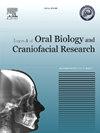手术刀和二极管激光技术治疗牙龈色素沉着的比较疗效:一项采用RGB摄影量化的裂口随机对照试验
Q1 Medicine
Journal of oral biology and craniofacial research
Pub Date : 2025-05-14
DOI:10.1016/j.jobcr.2025.05.001
引用次数: 0
摘要
牙龈美学是微笑吸引力的组成部分,它会受到色素沉着的显著影响。由黑色素细胞产生的黑色素有助于这种色素沉着,这可以通过各种色素沉着技术来解决。本研究旨在比较传统手术刀和二极管激光治疗牙龈色素脱色的效果。材料和方法:本试验采用双侧上颌牙龈色素沉着的随机对照试验。每个参与者用手术刀治疗一个六分仪(第一组),对侧六分仪用二极管激光(940 nm)治疗(第二组)。评估的参数包括术中出血、术后疼痛(VAS)、伤口愈合(伤口愈合指数)和色素沉着(Dummett口腔色素沉着指数)。使用RGB摄影分析来量化颜色变化。结果两组患者术中出血比较,差异无统计学意义(p = 0.31)。组2术后疼痛在第1天明显减轻(p = 0.01),但在第7天差异无统计学意义(p = 0.25)。第7天和第6个月的伤口愈合评分比较,但第2组在第12个月的伤口愈合评分明显优于第2组(p = 0.01)。第2组在6个月时色素沉着减少显著(p = 0.01),但在12个月时差异无统计学意义(p = 1.00)。RGB分析显示,第2组对色素沉着的控制较好,在多个时间点红、绿、蓝值差异显著(p <;0.001)。结论与手术刀技术(1组)相比,二极管激光治疗(2组)具有更好的美学效果,减少了术后疼痛,并能更有效地控制色素沉着。RGB分析提供了有价值的客观数据来支持这些发现。本文章由计算机程序翻译,如有差异,请以英文原文为准。
Comparative efficacy of scalpel and diode laser techniques in gingival depigmentation: A split-mouth randomized controlled trial with RGB photographic Quantification
Background
Gingival aesthetics, integral to a smile's attractiveness, can be significantly impacted by pigmentation. Melanin, produced by melanocytes, contributes to this pigmentation, which can be addressed through various depigmentation techniques. This study aims to compare the efficacy of conventional scalpel and diode laser methods for gingival depigmentation using RGB photographic analysis.
Materials and methods
This split-mouth, randomized controlled trial involved five participants with bilateral maxillary gingival hyperpigmentation. One sextant per participant was treated with a scalpel (Group 1), and the contralateral sextant was treated with a diode laser (940 nm) (Group 2). Parameters assessed included intraoperative bleeding, postoperative pain (VAS), wound healing (Wound Healing Index), and pigmentation (Dummett Oral Pigmentation Index). RGB photographic analysis was used to quantify colour changes.
Results
No significant difference was observed in intraoperative bleeding between the groups (p = 0.31). Postoperative pain was significantly lower in Group 2 on Day 1 (p = 0.01), though this difference was not significant by Day 7 (p = 0.25). Wound healing scores were comparable at 7 days and 6 months but were significantly better in Group 2 at 12 months (p = 0.01). Pigmentation reduction was significantly greater in Group 2 at 6 months (p = 0.01), but the difference was not significant at 12 months (p = 1.00). RGB analysis revealed that Group 2 achieved superior control of pigmentation, with significant differences in red, green, and blue values at multiple time points (p < 0.001).
Conclusion
Diode laser treatment (Group 2) demonstrated superior aesthetic outcomes and reduced postoperative pain compared to the scalpel technique (Group 1), along with more effective long-term pigmentation control. RGB analysis provided valuable objective data supporting these findings.
求助全文
通过发布文献求助,成功后即可免费获取论文全文。
去求助
来源期刊

Journal of oral biology and craniofacial research
Medicine-Otorhinolaryngology
CiteScore
4.90
自引率
0.00%
发文量
133
审稿时长
167 days
期刊介绍:
Journal of Oral Biology and Craniofacial Research (JOBCR)is the official journal of the Craniofacial Research Foundation (CRF). The journal aims to provide a common platform for both clinical and translational research and to promote interdisciplinary sciences in craniofacial region. JOBCR publishes content that includes diseases, injuries and defects in the head, neck, face, jaws and the hard and soft tissues of the mouth and jaws and face region; diagnosis and medical management of diseases specific to the orofacial tissues and of oral manifestations of systemic diseases; studies on identifying populations at risk of oral disease or in need of specific care, and comparing regional, environmental, social, and access similarities and differences in dental care between populations; diseases of the mouth and related structures like salivary glands, temporomandibular joints, facial muscles and perioral skin; biomedical engineering, tissue engineering and stem cells. The journal publishes reviews, commentaries, peer-reviewed original research articles, short communication, and case reports.
 求助内容:
求助内容: 应助结果提醒方式:
应助结果提醒方式:


